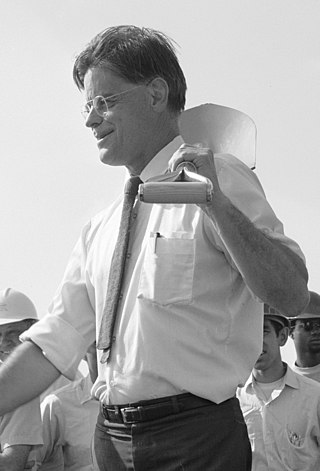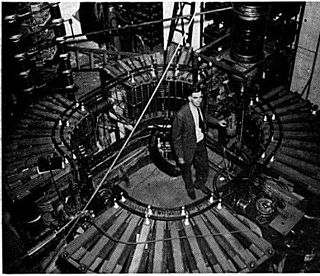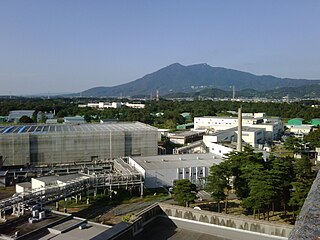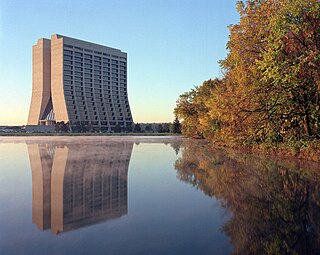Related Research Articles

Particle physics or high-energy physics is the study of fundamental particles and forces that constitute matter and radiation. The field also studies combinations of elementary particles up to the scale of protons and neutrons, while the study of combination of protons and neutrons is called nuclear physics.

SLAC National Accelerator Laboratory, originally named the Stanford Linear Accelerator Center, is a federally funded research and development center in Menlo Park, California, United States. Founded in 1962, the laboratory is now sponsored by the United States Department of Energy and administrated by Stanford University. It is the site of the Stanford Linear Accelerator, a 3.2 kilometer (2-mile) linear accelerator constructed in 1966 that could accelerate electrons to energies of 50 GeV.

Fermi National Accelerator Laboratory (Fermilab), located in Batavia, Illinois, near Chicago, is a United States Department of Energy national laboratory specializing in high-energy particle physics.

The Tevatron was a circular particle accelerator in the United States, at the Fermi National Accelerator Laboratory, east of Batavia, Illinois, and was the highest energy particle collider until the Large Hadron Collider (LHC) of the European Organization for Nuclear Research (CERN) was built near Geneva, Switzerland. The Tevatron was a synchrotron that accelerated protons and antiprotons in a 6.28 km (3.90 mi) circumference ring to energies of up to 1 TeV, hence its name. The Tevatron was completed in 1983 at a cost of $120 million and significant upgrade investments were made during its active years of 1983–2011.

A linear particle accelerator is a type of particle accelerator that accelerates charged subatomic particles or ions to a high speed by subjecting them to a series of oscillating electric potentials along a linear beamline. The principles for such machines were proposed by Gustav Ising in 1924, while the first machine that worked was constructed by Rolf Widerøe in 1928 at the RWTH Aachen University. Linacs have many applications: they generate X-rays and high energy electrons for medicinal purposes in radiation therapy, serve as particle injectors for higher-energy accelerators, and are used directly to achieve the highest kinetic energy for light particles for particle physics.

Robert Rathbun Wilson was an American physicist known for his work on the Manhattan Project during World War II, as a sculptor, and as an architect of the Fermi National Accelerator Laboratory (Fermilab), where he was the first director from 1967 to 1978.

A synchrotron is a particular type of cyclic particle accelerator, descended from the cyclotron, in which the accelerating particle beam travels around a fixed closed-loop path. The strength of the magnetic field which bends the particle beam into its closed path increases with time during the accelerating process, being synchronized to the increasing kinetic energy of the particles.

The International Linear Collider (ILC) is a proposed linear particle accelerator. It is planned to have a collision energy of 500 GeV initially, with the possibility for a later upgrade to 1000 GeV (1 TeV). Although early proposed locations for the ILC were Japan, Europe (CERN) and the USA (Fermilab), the Kitakami highland in the Iwate prefecture of northern Japan has been the focus of ILC design efforts since 2013. The Japanese government is willing to contribute half of the costs, according to the coordinator of study for detectors at the ILC.

The High Energy Accelerator Research Organization, known as KEK, is a Japanese organization whose purpose is to operate the largest particle physics laboratory in Japan, situated in Tsukuba, Ibaraki prefecture. It was established in 1997. The term "KEK" is also used to refer to the laboratory itself, which employs approximately 695 employees. KEK's main function is to provide the particle accelerators and other infrastructure needed for high-energy physics, material science, structural biology, radiation science, computing science, nuclear transmutation and so on. Numerous experiments have been constructed at KEK by the internal and international collaborations that have made use of them. Makoto Kobayashi, emeritus professor at KEK, is known globally for his work on CP-violation, and was awarded the 2008 Nobel Prize in Physics.

Thomas Jefferson National Accelerator Facility (TJNAF), commonly called Jefferson Lab or JLab, is a US Department of Energy National Laboratory located in Newport News, Virginia.

The Collider Detector at Fermilab (CDF) experimental collaboration studies high energy particle collisions from the Tevatron, the world's former highest-energy particle accelerator. The goal is to discover the identity and properties of the particles that make up the universe and to understand the forces and interactions between those particles.
Stochastic cooling is a form of particle beam cooling. It is used in some particle accelerators and storage rings to control the emittance of the particle beams in the machine. This process uses the electrical signals that the individual charged particles generate in a feedback loop to reduce the tendency of individual particles to move away from the other particles in the beam.

Nigel Stuart Lockyer is a British-American experimental particle physicist. He is the current director of the Cornell Laboratory for Accelerator-based ScienceS and Education (CLASSE) as of May 1, 2023. He was the Director of the Fermi National Accelerator Laboratory (Fermilab), in Batavia, Illinois, the leading particle physics laboratory in the United States, from September 2013 to April 2022.
The Universities Research Association (URA) is a non-profit association of more than 90 research universities, primarily but not exclusively in the United States. It has members also in Japan, Italy, and the United Kingdom. It was founded in 1965 at the behest of the President's Science Advisory Committee and the National Academy of Sciences to build and operate Fermilab, a National Accelerator Laboratory.

Helen Thom Edwards was an American physicist. She was the lead scientist for the design and construction of the Tevatron at the Fermi National Accelerator Laboratory.

A particle accelerator is a machine that uses electromagnetic fields to propel charged particles to very high speeds and energies to contain them in well-defined beams. Small accelerators are used for fundamental research in particle physics. Accelerators are also used as synchrotron light sources for the study of condensed matter physics. Smaller particle accelerators are used in a wide variety of applications, including particle therapy for oncological purposes, radioisotope production for medical diagnostics, ion implanters for the manufacturing of semiconductors, and accelerator mass spectrometers for measurements of rare isotopes such as radiocarbon.
Project-X is a proposed high-intensity proton accelerator complex which is to be built at the Fermi National Accelerator Laboratory. It is planned to produce beams of different energies up to 8 GeV for precision experiments involving kaons and muons. The complex can also be used to create a high-intensity neutrino beam for neutrino oscillation experiments such as NOνA and the Long Baseline Neutrino Experiment. Project-X will be based on superconducting RF components such as those developed for the International Linear Collider.
The Deep Underground Neutrino Experiment (DUNE) is a neutrino experiment under construction, with a near detector at Fermilab and a far detector at the Sanford Underground Research Facility that will observe neutrinos produced at Fermilab. An intense beam of trillions of neutrinos from the production facility at Fermilab will be sent over a distance of 1,300 kilometers (810 mi) with the goal of understanding the role of neutrinos in the universe. More than 1,000 collaborators work on the project. The experiment is designed for a 20-year period of data collection.
Nikolitsa (Lia) Merminga is a Greek-born accelerator physicist. In 2022, she was appointed director of Fermi National Accelerator Laboratory, the first woman to hold the position. She has worked at other national laboratories in Canada and the United States.

Fionn Miguel Eckardt Ferreira is an Irish inventor, chemistry student and Forbes 30 under 30 listee. He is known for his invention of a method to remove microplastic particles from water using a natural ferrofluid mixture.
References
- 1 2 3 4 5 6 7 Carter, Gercine (April 9, 2017). "Bajan's wand ready for next oil spill". NationNews.com. St Michael, Barbados. Retrieved August 15, 2021.
- ↑ City College of New York – Annual Report 2004-2005 (PDF). New York City: City College, City University of New York. 2005. p. 8.
- ↑ "Roosevelt Warner". Lyndhurst Funeral Home. April 29, 2021. Retrieved August 16, 2021.
Brother of Ean Warner, Keith Hinds (UK) / Philmore and Rawle Warner, Vanthyia Blackman, Dr Arden Warner, Sonia Warner-Gaskin, Shanell Warner-Brathwaite (all of the USA) / and the late MacHenley Warner, Wendell Warner, Tyronne Catlyn, Carlisle Catlyn. ... Brother-in-law of Rossana Warner, Vernice and Yvette Cummins, Junie Cummins (of Canada), Deborah and Eulalie Warner, Mitch Blackman, Dr Lena Hatchett, Leroy Gaskin, Leon Brathwaite (all of the USA)
- 1 2 Armitage, Hanae (July 30, 2014). "Accelerator physicist invents new way to clean up oil spills". Fermilab Today. Fermi National Accelarator Laboratory. Retrieved August 15, 2021.
- 1 2 3 Barbu, Brianna (February 22, 2021). "One minute with Arden Warner, accelerator physicist". Fermilab. Batavia, IL. Retrieved August 15, 2021.
- ↑ "Proton Improvement Plan II". PIP2 at Fermilab. Fermilab. Retrieved August 15, 2021.
- ↑ "STEM Inspiration leads Argonne Intern on Electrical Engineering Path". Department of Energy (US). March 26, 2019. Retrieved August 18, 2021.
- ↑ "Summer Internships in Science & Technology (SIST)". Fermilab. Retrieved August 18, 2021.
... the longest operating internship program in the Department of Energy National Laboratory system ...
- ↑ "Cleaning Oil Spills with Abundant Earth Magnet". Green Optimistic. January 21, 2016. Retrieved August 18, 2021.
- ↑ Biello, David (August 7, 2014). "Spill Some Oil? Magnetize It for Cleanup". Scientific American . Retrieved August 20, 2021.
- ↑ Gertz, Emily (August 7, 2014). "To Clean Up Oil Spills, Magnetize The Oil First". Popular Science. Retrieved August 20, 2021.
- ↑ "TEDxNaperville: Theme:SHIFT". TED.com. TED. November 6, 2015. Retrieved August 28, 2021.
...Arden now has a doctorate, working by day as an Accelerator physicist at Fermi National Accelerator Laboratory and after hours as a tinkerer, attempting to solve problems...
- ↑ Warner, Arden; Cathey, David; Cullen, Gary; Kasper, Peter; Lumpkin, Alex; Nelson, John (2018). "Development of the Electromagnetic Boom and MOP System (EMOP)". Proceedings of the 6th Int. Beam Instrumentation Conf. IBIC2017: 1–5. doi:10.18429/JACoW-IBIC2017-TULAB1 . Retrieved August 20, 2021.
- ↑ Sauers (Fermi National Accelerator Laboratory), Aaron (October 11, 2019). "Meet the new prototype in electromagnetic oil spill remediation technology". phys.org. Retrieved August 15, 2021.
- ↑ "An Investigation into the Removal of Microplastics from Water Using Ferrofluids (ISEF, Booth:CHEM004)". abstracts.societyforscience.org. Retrieved May 26, 2021.
- ↑ Warner, Arden (May 1, 2009). "The design and implementation of the machine protection system for the Fermilab electron cooling facility". INSPIRE (HEP – High-Energy Physics). et al. Retrieved August 15, 2021.
- ↑ Warner, Arden (October 8, 2017). "Machine Protection System Research and Development for the Fermilab PIP-II Proton Linac". INSPIRE (HEP – High-Energy Physics). et al. Retrieved August 15, 2021.
- ↑ "Meet the Board". The Millennium Fund. Barbados.